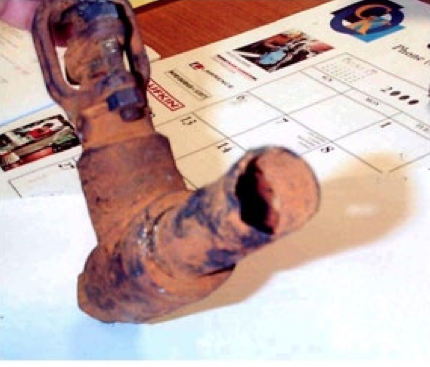Introduction
Small bore piping is present in many variations throughout numerous industries. This article will address an incident involving a small bore piping failure that occurred on a 140,000 BPD crude distillation unit in the refining industry. This incident not only resulted in a near fatality, but millions of dollars in repairs and lost production.
The incident involved a 3⁄4” bleeder valve attached to a bell head on a set of kerosene heat exchangers that were found to be performing ineffectively. These exchangers utilized cooling water on the tube-side to cool kerosene running through the shell-side. When it was found that the exchangers were not cooling the product effectively, operators working in the unit sprayed fire-monitor water onto the shell to help improve cooling. It should be noted that although this is a common practice in some refineries, this practice is NOT condoned throughout the industry as a whole. Adjacent to the kerosene heat exchangers being sprayed down with fire water were a set of naphtha preheaters which were used to heat, what unit operators called, “wild naphtha”, on its way to the debutanizer tower. It was called “wild naphtha” because of the high butane content in the process stream. The naphtha preheaters were insulated and the back heads had insulation blankets on them, as shown in Figure 1. The overspray from the kerosene cooler’s external cooling effort was soaking the insulation blankets on these heads.

These insulation blankets needed to be removed in order to detach the head covers to facilitate cleaning of the naphtha preheaters. During removal of the insulation blanket, one of the stainless steel wires used to hold the blanket in place was wrapped around the 3⁄4” bleeder valve on the bottom of the bell head when the waterlogged blanket slipped off of the head & fell to the ground. The 3⁄4” valve broke off between the valve and the head dumping the butane rich naphtha onto the exchanger below and flooding the area with the product.

An operator who had witnessed the incident tried to block in the exchangers, but the liquid ignited before he could finish. The operator was caught in the flames and was severely burned, but was able to escape.
The crude distillation unit was subsequently brought down at a cost of millions of dollars due to repairs and lost production.
Post-incident Investigation
An important question that came out of this post-incident investigation was, “how many small bore connections out there are exactly like this?” That question spawned a Small Bore Inspection Program that was later launched in a 340,000 BPD refinery. The Inspection Program included every small bore branch connection and root valve that was in hydrocarbon service at the refinery.
The following paragraphs will serve to explain how that Small Bore Inspection Program was carried out, as well as, address other efforts that were put in place to avoid this type of incident happening again.

















Comments and Discussion
Add a Comment
Please log in or register to participate in comments and discussions.